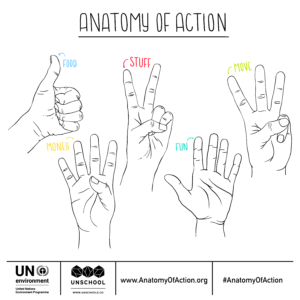In partnership with the United Nations Environment Program, designer, sociologist and 2016 UNEP Champion of the Earth Dr. Leyla Acaroglu shares her Anatomy of Action initiative to activate and ignite sustainable living, due to launch in partnership with the UNEP on Sept. 12, 2019.
The world is made up of complex, interconnected systems, and many of those constructed by humans are failing us. Air pollution, deforestation, the sixth great extinction, ocean plastic waste, and the consequences of a climate in crisis all originate from one driving force: consumption. The demands that our “needs” place on the natural systems that sustain us are in an unprecedented state of affect, while ever-expanding consumption patterns are directly linked to the structure of the globalized economy and the design of the everyday things that fill our lives.
Sustainable Development Goal 12, Sustainable Production and Consumption, is thus a critical focal point in addressing nearly all other SDGs, whether we’re talking about biodiversity impacts that result from material extraction, or airborne contamination connected to transport systems and manufacturing, to plastic pollution resulting from mass-produced convenience products. From poverty alleviation to access to clean drinking water to promoting fair wages, all of the SDGs are impacted by the global supply chain, which externalizes the environmental and social impacts associated with delivering goods and services into the economy.
The critical intervention point in meeting the goals of SDG12 is unraveling the grip that status-based consumption patterns, analyzed in a study by Donghee Kim and Soocheong Jang, hold over people’s lifestyle choices, and then finding ways to support the rapid uptake and normalization of sustainable living practices. This is, of course, far easier said than done — there are a multitude of issues of social change, equity and access involved, along with significant resistance from industry, all of which need to be addressed if we’re to transition to a circular and sustainable economy.
Challenges are always opportunities in disguise though, and addressing SDG12 (well before it was so named!) has been a personal life goal. As a designer and sociologist, the relationship between the designed material world and the social conventions that respond to — and thus reinforce — the design and production of certain goods and services has been at the forefront of my work to bring about a sustainable future by design. I have designed many projects that have sought to chip away at models of hyper-consumption and inspire a new generation of designers to adopt tools of sustainable and circular systems design.
In connection to my work with designers and producers, I have also long been fascinated by the complexities of evoking consumption changes that then motivate companies and creatives to alter the way they design and produce goods. One side of the coin says they need consumer demand to justify the investment of retooling for a circular economy, while the other side complains of the associated expense or lack of variety when it comes to purchasing sustainable goods and services. The deflection of responsibility is persistent throughout the value chain, and we’re all implicated in the outcomes of unsustainable production and consumption. So when the UN Environnment’s Economic Division invited me to collaborate on an initiative to make sustainable living accessible and actionable, it was a challenge I was quite excited to tackle. Knowing the pitfalls of oversimplifying the issue and only tackling the lifestyle aspect, I wanted to ensure that the work we did was based on finding ways to support a systemic restructuring of the culture of consumption, as well as to build and expand upon what was organically evolving in reaction to the disposability crises we’ve seen, especially in the last decade.
Systems ReDesign
Our current economic system externalizes the environmental costs of consumption. We have unintentionally designed a global system that sustains unsustainability and promotes ecological destruction in the name of continuous economic growth. We all know that we live on a finite planet with limited resources that stay locked within the confines of Earth after they have been discarded. We are now seeing and feeling the direct effects of 70 years of an economic system designed to promote continual growth — i.e., Gross Domestic Product (GDP) — within the limits of a planet that by design, metabolizes all resources.
As humans, we love stuff — or more to the point, we love being in love with things, we love having an easy and convenient life, and so it’s easy for us to be encouraged to buy, own, and discard one thing for the next best thing. The social dimension of sustainability is about recoding the rewards that an exponential growth-based model has incentivized.
The circular economy movement is seeking to redirect the role of design, production, and consumption toward a system of sustainable regeneration, as opposed to the extraction-based linear economic model in which we currently all live. Yet this in itself does not remedy the incentives motivating a waste-based society. As humans, we love stuff — or more to the point, we love being in love with things, we love having an easy and convenient life, and so it’s easy for us to be encouraged to buy, own, and discard one thing for the next best thing. The social dimension of sustainability is about recoding the rewards that an exponential growth-based model has incentivized.
The GDP measure was developed initially as an accounting tool to assess the viability of a nation — in the first case, the USA’s ability to recover from the Great Depression and later, to assess if there were enough resources to win the war. The fact that it was quickly taken up by all nations as the main tool for measuring economic success was never intended by its designer Simon Cuznicks, who himself said it was not good for measuring the true wealth of nations. The systemic issue with GDP is that it only accounts for goods and services after they have been produced, which means that we systematically discount all prior aspects of the materials, resources, and labor required to meet the needs of the economy. The impacts, for example, on non-economic aspects of extracting minerals or the cost of pollution, are completely externalized, and thus we’ve built a system of extraction and exploitation, one that prioritizes profits over both human and ecosystem health.

We’ve reached a tipping point of sorts in which many countries are overwhelmed by the exponential growth of waste. We’ve justified these excessive consumption patterns by pitching recycling as the savior solution, but recycling is flawed in that it validates the production of more waste and cognitively alleviates the guilt that people feel in producing and consuming something that’s deemed “recyclable.” This then raises the question: who is responsible for dealing with the byproducts of our collective actions? Until recently, China was taking most of the world’s trash, but since they refused to continue to receive it in 2018, recyclables are being stockpiled, landfilled, or dumped around the world as the recycling industry is in crisis with many other countries previously being dumped on now demanding that the wealthy nations take back their trash; a recent high profile case highlighted this as it involved several containers of plastic recyclables from Canada being returned from the Philippines. Western countries are now scrambling to find alternatives. They themselves are dealing with a disposable packaging explosion, with their own waste systems struggling to cope with the increase in local disposable plastic waste generation.
Indeed, there is no one-size-fits-all solution to the complex social and environmental issues we face as a global community. There are, instead, many immense possibilities for creative and socially transformative practices, policies, products, and processes — as well as a significant opportunity for positive economic development without environmental exploitation, if we invest in change at multiple points within the systems in which we all participate. This is specifically related to redesigning systems that sustain unsustainability and leveraging the role of everyday actions to support changes at the local context, with the intent to influence larger players within the system. After all, the economy is made up of micro-actions accumulating into macro-outcomes that we see.

This is the foundational concept underpinning the Anatomy of Action, the initiative that my team and I at the UnSchool developed in collaboration with the UN Environment Program. Evolving out of research that we conducted, which examined the organically-building movements that support sustainable lifestyles, we then cross-evaluated our findings with the latest peer-reviewed data on which actions can have positive systemic impacts if adopted by many. These were then connected to tangible everyday actions that individuals anywhere can take.
As a proposition, the initiative seeks to build and expand the already growing movements towards sustainability, offer positive reinforcement to these already opting into the transition, and provide a reference for why lifestyle changes can be so beneficial to those that are new to this. I’m under no illusion that there is one solution to the complex problems we face, but I do know from a sociological perspective that change happens when individuals challenge the dominant structures maintaining the status quo by taking actions, altering practices, and engaging with new knowledge. So, addressing social norms, finding habit disruptors, and igniting a chain reaction of sustainable lifestyle swaps was the goal for this initiative.
Addressing the Social Norms of UnSustainability
In the book, “Social Norms,” authors Michael Hechter and Karl-Dieter Opp define social norms as the informal understanding of appropriate social behaviors that subtly govern societies. They differ from place to place but have similar impacts in shaping the social cues of what’s expected of a person’s behavior in order for them to “fit in.” The innate desire to be socially accepted supports the uptake of social norms, and thus they are replicated, spreading through social contagion to dictate what is considered “normal.”
Most recently, we’ve seen a significant shift toward the normalization of unsustainable lifestyle choices, such as hyper-disposability in daily life. A paper by Jacqueline K. Eastman, Ronald E. Goldsmith and Leisa Reinecke Flynn argues that the more people who associate social status with holding a disposable coffee cup, for example, the more people desire the perceived associated benefits that having that cup gives them. Thus, we see the rapid rise of disposable products as the cognitive association of wealth and status reinforces this loop.

Anthony Giddens’ Structuration Theory and Elizabeth Shove’s Social Practice Theory both speak to the notion that change occurs when agents within a system are enabled to alter their practices, changing what is considered culturally acceptable, which in turn affects others’ practices and encourages a cascade of change that affects social conventions. For Richard Dawkins, the notion of social contagion of practice is embedded in his now-infamous “meme” concept, where he originally associated the way viruses transfer between carriers to the way ideas and practices are transferred as social units between humans. We “catch” ideas and behaviors from others, and this is how we see the rapid uptake of certain trends — as well as how we see social change happen, in any direction.
Social norms, and the structural forces that reinforce them, cannot be underestimated when seeking to address the cultural shifts needed to bring about the transition to a more sustainable future. What is required is a seismic shift in cultural values that then affects the way we value human labor, the natural resources the planet provides, and the collective impact that we have on our life-sustaining systems.
Finding Habit Disruptors
In their article, “Habit Formation and Change,” published in the Current Opinion in Behavioral Sciences journal, Lucas Carden and Wendy Wood assert that disrupting normalized habits by offering up alternatives to the dominant unsustainable social practices allows for choice interventions to be presented as viable alternatives for people to opt into. Encouraging swaps from an existing norm to a new habit — such as utilizing a reusable coffee cup instead of accepting a disposable one — requires an opportunity to experience the disruption of an existing habit and then replace it with the new one in a non-confrontational environment. If the swapper finds the experience easy and the new norm desirable, then they are more likely to adopt the new practice and share their successes with others. The more people who opt into sustainable lifestyle practices, the more prevalence it has, thus offering the opportunity for normalization.
A study by Satoshi Fujii, Tommy Gärling and Ryuichi Kitamura found this to be the case when looking at the change effects of temporary freeway closures on commuters. People who used their cars frequently were more likely to opt for a longer drive route rather than swapping to a more efficient public transport option. But in some cases, when drivers opted to try public transport alternatives, and found that this option was not as long and painful as first assumed, they continued with this new behavior after the freeway had reopened. Essentially, people just need a demonstrable reason to try something new.
Designing experiences that alter decision structures can help the formation of new habits, as many habits are the product of the interaction of persons and their environments, resulting in cues that trigger actions such as the association of status with consumption.
The “habit discontinuity hypothesis,” tested recently in a study by Bas Verplanken and Deborah Roy, states that habit-changing interventions are more likely to be effective when they are delivered during life changes. Furthermore, interventions that encourage habit swaps are often more successful when the environment in which the habit is performed is altered, according to the article, “Habit Formation and Change.” The moments throughout people’s lives when changes naturally occur — such as starting a new job, moving houses, having a child, etc., — these life course transitions offer perfect intervention points for supporting habit changes. Designing experiences that alter decision structures can help the formation of new habits, as many habits are the product of the interaction of persons and their environments, resulting in cues that trigger actions such as the association of status with consumption.
Igniting a Chain Reaction of Change
The goal of igniting a chain reaction of positive change is about seeding new normative practices and cultural conventions that support a more sustainable future. Specifically when it comes to daily life choices and consumption habits, this is about offering viable alternatives and decoupling successes with status-based ownership.
A sustainable lifestyle is defined by the UNEP as “a cluster of habits and patterns of behaviour embedded in a society and facilitated by institutions, norms and infrastructures that frame individual choice, in order to minimize the use of natural resources and generation of wastes, while supporting fairness and prosperity for all.” At the micro-level, this is about transforming choices individuals make, as they operate within and contribute to the economy. It is also about finding ways of supporting a better understanding of the role that natural environments play in supporting all life on Earth, along with the macro-level changes to supply chains, production techniques, product design, policy development and ultimately, the incentives that reinforce unsustainability through the GDP-based continuous growth system. All of these aspects of society will affect the transition toward a circular and regenerative economy.
However, there is a need to warn of the dangers of reductionism when approaching sustainable lifestyles. An issue with which I constantly grapple, and remain conflicted in all of my projects, is the simplification of recommendations that disconnects from the core problems; focusing only on the negative also disengages people from those core issues. So there’s a fine line between communicating an invitation to change and the reasons why that change needs to occur — without turning people off or making it seem like one small act will change the world. Furthermore, it can not be only consumers’ responsibility, nor only producers’; each agent in society plays a role in influencing the others, and the ultimate enforcer of unsustainability is the design of the extractionary economy. In order to change the macro aspects and transition to a circular economy, we need to alter the dominant values and actions of daily life.
The Anatomy of Action
Using this understanding of how to ignite social change from a systems-redesign perspective, and activating individual lifestyle choices based on the assumption that multiplied en masse small changes impact the larger economy, the Anatomy of Action focuses on normalizing lifestyle swaps rather than forcing hardline changes. The hypothesis is that we can incentivise people to make a change by swapping one dominant choice to another, gain small wins, enjoy the experience, and then adopt the new behavior, share it with others, and see it become more “normal.”
Each of us makes choices every day that impact on the world around us. Since we often use our hands to take these actions, the simple memetic concept of the Anatomy of Action is a visual reference to a hand, with each finger representing a different lifestyle area where swaps can be made: the food we eat, the stuff we buy, how we move, the ways we spend our money, and the fun things we do. Each of these five main lifestyle themes have three sub-actions that are positively focused, such as “protein swaps,” “beyond buying” and “choose experiences.” Individual changes not only help change the local and global economy (as many industries respond to consumer demand), but they also have impacts across the entire supply chain and help to normalize these new actions to others around us, creating a chain reaction of change. Moreover, many companies and governments respond to the preferences of consumers, so it can help to shift what products and services are designed and made available.
There is a fundamental need for systemic restructuring of consumption patterns in order to achieve SDG12, and by association, all of the SDGs. By focusing on either consumption habits or production techniques alone, we will not evolve the systems-wide adjustments needed to create a widespread activation of sustainable production and consumption. These are deeply interconnected; with demand and supply influencing each, however, the tides are changing, and consumption choices are shifting toward healthier, more sustainable preferences. The objective for the Anatomy of Action is to highlight and expand on these by validating the benefits of individual actions to support the global shifts needed to bring about the SDGs in a way that makes sustainable living not just necessary, but irresistible.



















